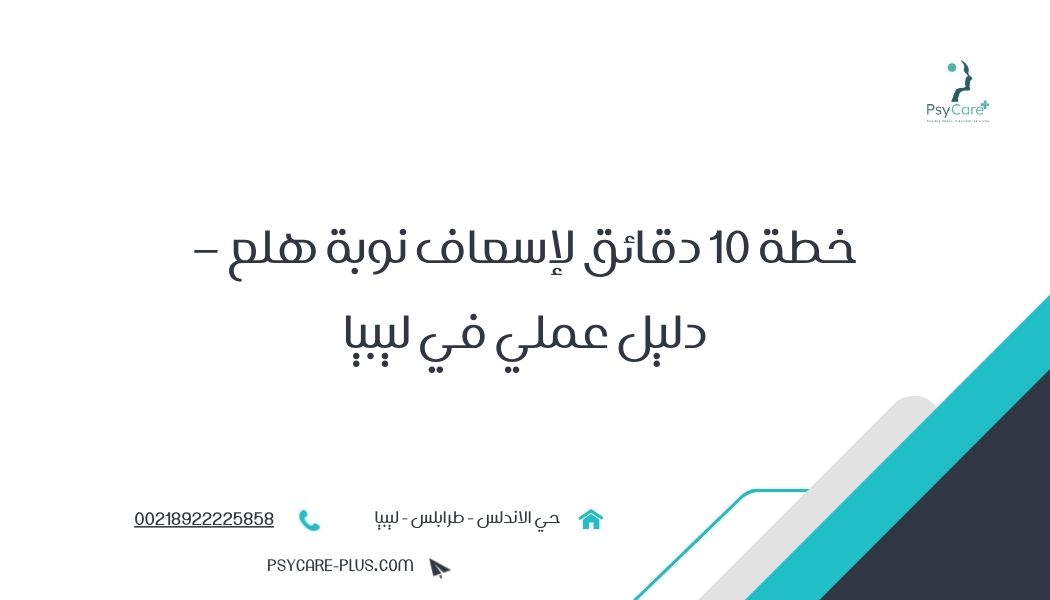A 10-Minute Panic Attack Aid Plan — A Practical Guide for Libya
Minute-by-Minute Protocol + Fast Calming Tools + Ritual Blocking + 7-Day Follow-Up

A 10-Minute Panic Attack Aid Plan — A Practical Guide for Libya
Important: This plan is for education and self-support, not an emergency service. For acute medical/psychiatric risk, contact local emergency services first. For non-urgent care, book online via Therapists or download PyCare Plus on Google Play. Learn about us: Who We Are — More guides: Blog — Questions: Contact Us.
Why panic attacks happen
A panic attack is a sudden wave of high arousal (palpitations, air hunger, dizziness, sweating, tremor, chest tightness, tingling) that rises and falls within minutes. Your brain fires a false alarm when there’s no actual danger. Catastrophic thoughts jump in: “I’ll faint,” “I’ll lose control,” “I’m having a heart attack.”
The good news: the wave peaks and subsides naturally. What maintains the cycle are safety behaviors—pulse checking, immediate escape, constant water, reassurance seeking. They bring short relief but “teach” your brain the alarm was justified, so the loop returns.
The aim of the 10-minute plan
-
Label what’s happening: “panic alarm—not danger.”
-
Regulate the body (breathing + sensory grounding).
-
Block rituals (checking/escape/reassurance).
-
Behavioral survival: remain in context with minimal adjustments.
-
Set follow-up to prevent relapse over the next week.
10-Minute Protocol — Minute by Minute
Run it as written. If needed, repeat once.
Minute 0–1: Label & allow
-
Softly: “This is a panic alarm. The wave rises and falls by itself. I’ll let it pass.”
-
Upright posture, relax shoulders/jaw, one hand on belly.
Minute 1–3: 4–6 breathing (vagal tone)
-
Inhale 4s through the nose, exhale 6s through the mouth.
-
6–8 cycles, belly-led.
-
When thoughts intrude, return to breath—no debating.
Minute 3–4: 5-4-3-2-1 grounding (short)
-
3 things you see, 2 you touch, 1 you hear.
Shift attention from internal cues (heart/dizziness) to external senses.
Minute 4–5: Language swap
-
Replace “disaster/losing control” with “anxiety wave.”
-
Anchor line: “The wave is high but safe—breathing is turning it down.”
Minute 5–7: Block rituals
-
No pulse/O2 checking now.
-
No escape. If needed, adjust (stand by a wall/sit) while staying.
-
No reassurance calls during the first 10 minutes.
Minute 7–9: Gentle motion + quiet breath
-
Slow shoulder rolls 30–45s.
-
If standing: light knee bends ×10.
-
Repeat 4/6 breathing ×4 cycles.
Minute 9–10: Close the wave
-
Notice: the peak eased; you’re still here.
-
Closing line: “The wave passed. I continue my task.”
-
No post-panic analysis right now; it reignites the loop.
If the wave hasn’t eased, repeat minutes 1–5 once. If severe unfamiliar symptoms or medical risk exist, seek evaluation. Otherwise, stick to the plan.
Avoid during the attack
-
Googling symptoms.
-
Stimulants (coffee/energy drinks).
-
Hyperventilating.
-
Catastrophic self-talk.
-
Instant reassurance from others.
Pocket tools (30–60 seconds)
-
Ice/cold water on wrist 20–30s.
-
Count down 100 → 0 by threes.
-
Tiny cue card with the protocol lines.
-
Pleasant scent: one brief inhale to re-anchor.
Use one tool, then back to breathing.
One-minute debrief (no self-blame)
-
Context? (queue, car, meeting)
-
Peak intensity (0–10)?
-
Which ritual did I block?
-
How many minutes to subside?
-
One step for tomorrow? (1 extra minute in queue)
Safe interoceptive exposure — training your body
Deliberately evoke panic-like sensations gradually to teach your brain they’re safe:
-
Fast breathing 30s → air hunger.
-
Light jogging in place 60–90s → heartbeat.
-
Head spins 20–30s → dizziness.
-
Brief breath hold 10–15s → tightness.
Rule: after each drill, 4–6 breathing, no pulse checks, observe rise & fall.
Safety: If you have cardiac/respiratory conditions, are pregnant, or have severe vertigo—skip these or do them with a clinician via Therapists.
Why ritual blocking matters
-
Checking/escape/reassurance gives your brain false evidence of danger.
-
Blocking teaches: “I was safe—the wave fell without rituals.”
-
Taper first (e.g., pulse check once/day) → then none.
Ready-made scripts
Queue: “I’ll stand by the wall for a minute… 4/6 breathing… the wave is passing.”
Meeting: “Give me a breath… here’s the point.”
Car: “If it rises, I slow for a minute and continue.”
If words jam: “Let me rephrase—the key is…”
7-Day Follow-Up (customizable)
Day 1:
-
Save the 10-min protocol in your wallet/notes.
-
Practice in an easy context (short queue).
-
Block one ritual (no pulse checks all day).
Day 2:
-
One interoceptive drill 30s + ritual blocking after.
-
One real short context (one floor elevator).
-
Log peak/time.
Day 3:
-
Medium context (longer queue/small busy shop).
-
4/6 breathing + 3-2-1 grounding.
-
No reassurance for 60 minutes afterward.
Day 4:
-
Generalize to a different location.
-
Add one question in a meeting to practice staying present.
Day 5:
-
Slightly harder context (public transport/small mall).
-
Reduce pre-planned “escape routes.”
Day 6:
-
Review: which tool calmed fastest? where do rituals creep in?
-
Next-week target (stay 2–3 extra minutes).
Day 7:
-
Brief intake if needed (CBT/exposure plan): Book a therapist.
-
Make the 10-minute protocol your default.
FAQs
Will I faint? Dizziness is common; fainting is rare in panic (blood pressure usually rises slightly).
Do I need medication? Case-by-case with a psychiatrist if indicated.
Does online care work? Yes—when you use a clear plan, block rituals, and practice graded exposure.
Night attacks? Same protocol; add dim light, run 4/6 on the bed, limit blue-light screens.
Start now
-
Download & book: PyCare Plus — Google Play
-
Choose your clinician: Therapists
-
Meet us: Who We Are
-
Read more: Blog
-
Questions? Contact Us




